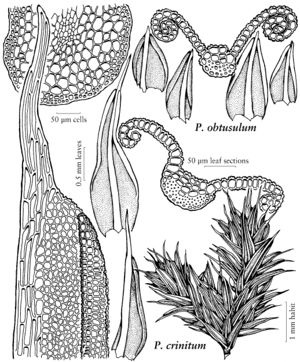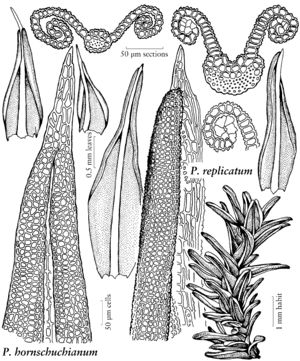Pseudocrossidium
Bull. Torrey Bot. Club 42: 396, plate 23. 1915 ,.
| Taxon | Illustrator ⠉ | |
|---|---|---|
 | Pseudocrossidium crinitum Pseudocrossidium obtusulum | Patricia M. Eckel Patricia M. Eckel |
 | Pseudocrossidium replicatum Pseudocrossidium hornschuchianum | Patricia M. Eckel Patricia M. Eckel |
Plants in cushions or turf, yellowish green to brown distally, brown to reddish-brown proximally. Stems 0.3–2 cm; hyalodermis absent or weakly differentiated, sclerodermis weakly differentiated, central strand usually present, often strong; axillary hairs of 5–8 cells, all hyaline or occasionally proximal 1–3 cells thicker walled. Stem-leaves appressed and often spiraled when dry, weakly or widely spreading when moist; ovate or ligulate to lanceolate, adaxial surface channeled or grooved along costa; base scarcely differentiated in shape to oblong; distal margins recurved to broadly revolute or spiraled, entire or occasionally weakly denticulate near apex, occasionally differentiated as a photosynthetic organ of thin-walled, hollow-papillose cells; apex acute to rounded; costa often swollen medially, excurrent as a mucro or short awn, [adaxial outgrowths occasionally differentiated as a pad of filaments of uniseriate, papillose cells,] adaxial cells quadrate to shortly rectangular, in 2–5 rows; transverse-section usually reniform to circular, adaxial epidermis present, adaxial stereid band absent [present and small (usually of 1–2 cells)], guide cells 2–4 (–6), in 1–2 layers, hydroid strand present, often multiple, occasionally absent, abaxial stereid band present, usually strong, crescentiform in section, abaxial epidermis present, often weak; proximal cells differentiated medially, occasionally across leaf, rectangular, 2–6: 1, walls of proximal cells thin to evenly thickened, occasionally porose, hyaline or occasionally orange; distal medial cells subquadrate, often transversely elongated, 8–16 (–18) µm wide, 1: 1 (–3), 1-stratose; papillae crowded, hollow, occasionally platelike or 2-fid or multiplex, usually crowded, cell-walls evenly thickened, weakly convex to bulging on both sides. Specialized asexual reproduction by small gemmae, clavate, seldom present, borne on adaxial surface of costa. Sexual condition dioicous. Perichaetia terminal, inner leaves weakly differentiated or convolute-sheathing and enlarged, often awned. Seta 1–2 cm. Capsule stegocarpous, theca elliptic to cylindric, occasionally curved, 1.6–3 mm, annulus of 2–4 rows of vesiculose cells, persistent; peristome teeth 16, cleft to base or 32, linear, to once-twisted counterclockwise, occasionally straight; operculum short to long-conic or conic-rostrate. Calyptra cucullate. Spores 8–12 µm. KOH laminal color reaction yellow to orange, occasionally with red blotches at mid leaf or above.
Distribution
North America, Mexico, Central America, South America, Europe, sw Asia, Australia
Discussion
Species 16 (4 in the flora).
Pseudocrossidium is characterized by the commonly ovate to elliptic leaves, rather small distal laminal cells, the small size or absence of the adaxial costal stereid band, the crescent shape of the abaxial stereid band, and lamina yellow or orange (with occasional red spots) in KOH (R. H. Zander 1993). Most but not all species have some elaboration of the cells of the adaxial epidermis or marginal cells of the leaf as photosynthetic organs or enlargement of the perichaetial leaves. The small distal laminal cells and yellow or orange KOH reaction will distinguish the species from Syntrichia, which is red in KOH, and has a similar costal anatomy but lacks an abaxial epidermis. See B. C. Tan et al. (1981) and Zander (1979, 1981, 1994n) for extensive discussion of the taxonomy and distribution of Pseudocrossidium in the Americas.
Selected References
Lower Taxa
Key
| 1 | Leaves long-mucronate to long-awned | > 2 |
| 1 | Leaves merely apiculate to short-mucronate | > 3 |
| 2 | Leaves rounded-obtuse at base of awn; costa concave adaxially, with 4 guide cells. | Pseudocrossidium crinitum |
| 2 | Leaves narrowly acute at base of awn; costa convex adaxially, with 2 guide cells | Pseudocrossidium hornschuchianum |
| 3 | Plants coarse, leaves comparatively long, 1-1.5 mm, ligulate to oblong-lanceolate, apex obtuse; costa concave adaxially, with (4-)6 guide cells. | Pseudocrossidium replicatum |
| 3 | Plants delicate, leaves short, 0.7-1.2 mm, ovate to ovate-deltoid, apex broadly acute; costa convex adaxially, with 2-3 guide cells. | Pseudocrossidium obtusulum |